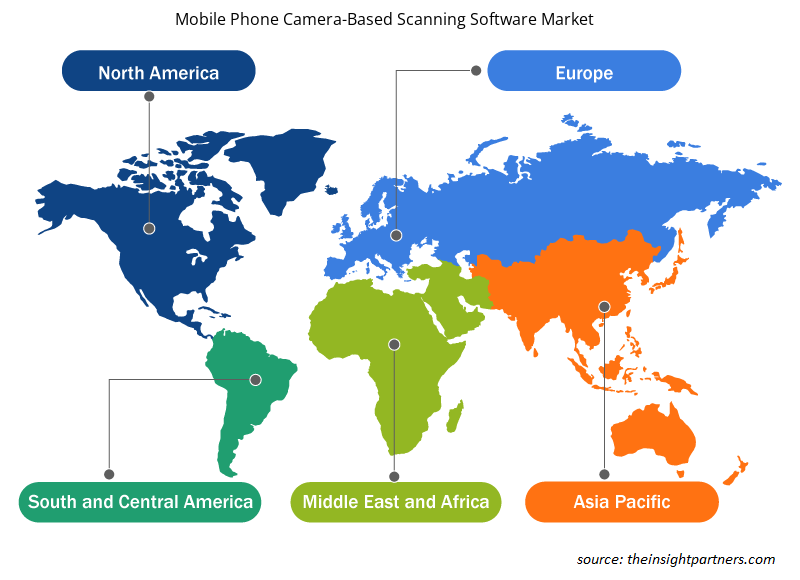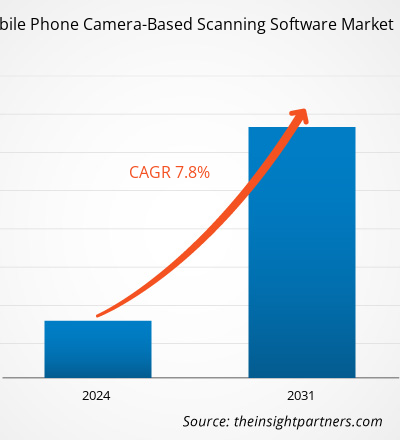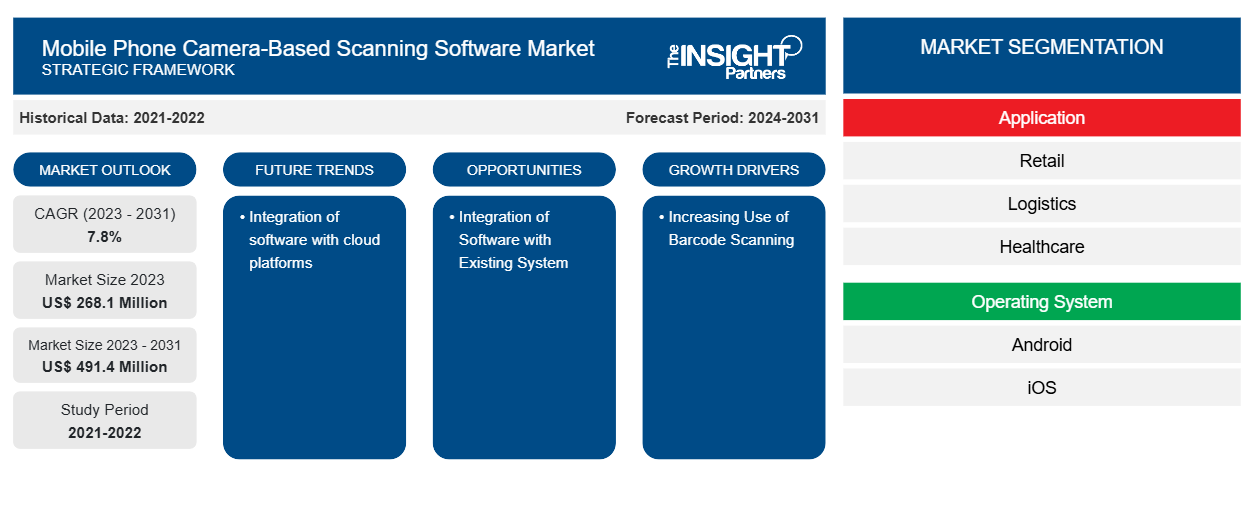Se proyecta que el tamaño del mercado de software de escaneo basado en cámaras de teléfonos móviles alcance los 491,4 millones de dólares estadounidenses para 2031, frente a los 268,1 millones de dólares estadounidenses en 2023. Se espera que el mercado registre una CAGR del 7,8 % durante 2023-2031. Es probable que la integración de software con plataformas en la nube siga siendo una tendencia clave en el mercado.
Análisis del mercado de software de escaneo basado en cámaras de teléfonos móviles
El software de escaneo está preparado para transformar la forma en que operan las empresas, brindando una multitud de ventajas sobre los lectores de códigos de barras de hardware tradicionales. Al adoptar una solución de escaneo basada en software, las empresas pueden aumentar la eficiencia, mejorar la precisión y obtener información valiosa, lo que en última instancia se traduce en crecimiento y éxito. El software de escaneo de códigos de barras ha revolucionado varias industrias, incluida la venta minorista, al agilizar la gestión de inventario, el seguimiento de productos y los procesos de pago. En logística, automatiza la recopilación de datos, el seguimiento de envíos y la optimización de las operaciones de almacén. En atención médica, mejora la identificación de pacientes, la administración de medicamentos y la gestión de registros médicos.
Descripción general del mercado de software de escaneo basado en cámaras de teléfonos móviles
El software de escaneo de códigos de barras utiliza algoritmos de software para decodificar códigos de barras recopilados con cámaras digitales o dispositivos móviles. A diferencia de los lectores de códigos de barras de hardware , que necesitan equipos especializados, las soluciones de software de códigos de barras se pueden integrar en los dispositivos y aplicaciones actuales, lo que proporciona una mayor flexibilidad y ahorro de costos. El software de escaneo se conoce comúnmente como API de escáner de códigos de barras o simplemente API de código de barras . El software de escaneo de códigos de barras ofrece una multitud de beneficios en comparación con los lectores de códigos de barras de hardware tradicionales . Ofrece flexibilidad y las soluciones se pueden ajustar fácilmente a varios escenarios de escaneo y configuraciones de cámara, lo que las hace adecuadas para una variedad de aplicaciones. El software que elimina la necesidad de hardware especializado reduce los costos iniciales. Además, las soluciones de software de escaneo a menudo requieren un mantenimiento y actualizaciones mínimos, lo que reduce los costos a largo plazo.
Personalice este informe según sus necesidades
Obtendrá personalización en cualquier informe, sin cargo, incluidas partes de este informe o análisis a nivel de país, paquete de datos de Excel, así como también grandes ofertas y descuentos para empresas emergentes y universidades.
-
Obtenga las principales tendencias clave del mercado de este informe.Esta muestra GRATUITA incluirá análisis de datos, desde tendencias del mercado hasta estimaciones y pronósticos.
Impulsores y oportunidades del mercado de software de escaneo basado en cámaras para teléfonos móviles
Aumenta el uso del escaneo de códigos de barras para favorecer el mercado
Las empresas, almacenes y otras instalaciones que dependen de la entrada manual de datos sufren una alta tasa de errores humanos. Los empleados que ingresan datos a mano tienen muchas más probabilidades de invertir números, saltarse una línea, malinterpretar un número o usar una letra terrible que otros no pueden leer. Los códigos de barras , por otro lado, reducen significativamente la probabilidad de error humano hasta el punto de eliminarla casi por completo. Los escaneos de códigos de barras son más eficientes, confiables y requieren menos tiempo que la entrada manual de datos. Las empresas que luchan por reducir los costos de mantenimiento de inventario también se benefician de la implementación de programas de códigos de barras . Los códigos de barras permiten a las empresas actualizar el inventario en tiempo real con actualizaciones inmediatas y precisas que brindan recuentos de inventario reales. Los recuentos de inventario más precisos contribuyen a mejorar la eficiencia porque permiten a las empresas establecer tiempos de entrega más precisos, una definición más precisa de los costos de inventario y un precio de mercado más alto. Por lo tanto, aumenta el uso de códigos de barras e impulsa el crecimiento del software de escaneo de códigos de barras basado en cámara .
Integración de software con sistemas existentes
El software de escaneo basado en cámara de teléfono móvil ofrece una gama de características y capacidades que van más allá del escaneo de códigos de barras tradicional , incluida la recopilación de datos, el procesamiento y la integración con sistemas o software existentes. Pueden sincronizar datos con bases de datos centrales, comunicarse con sistemas POS o software de gestión de inventario y transferir información de forma inalámbrica para garantizar actualizaciones y precisión en tiempo real. Este software se puede personalizar o desarrollar para integrarse sin problemas con sistemas existentes como software de gestión de inventario, sistemas de punto de venta ( POS ), software de gestión de relaciones con el cliente ( CRM ) y sistemas de planificación de recursos empresariales ( ERP ). Esta compatibilidad permite a las empresas aprovechar su infraestructura de software existente, optimizando la eficiencia operativa al máximo posible. Por lo tanto, la integración con los sistemas existentes crea una oportunidad para el crecimiento del mercado.
Análisis de segmentación del informe de mercado de software de escaneo basado en cámara de teléfono móvil
Los segmentos clave que contribuyeron a la derivación del análisis del mercado de software de escaneo basado en cámara de teléfono móvil son la aplicación y el sistema operativo.
- Según la aplicación, el mercado de software de escaneo basado en cámaras de teléfonos móviles está segmentado en comercio minorista, logística, atención médica, hotelería, correos y otros.
- En términos de sistemas operativos, el mercado está segmentado en Android e iOS.
Análisis de la cuota de mercado del software de escaneo basado en cámaras de teléfonos móviles por geografía
El alcance geográfico del informe de mercado de software de escaneo basado en cámara de teléfono móvil se divide principalmente en cinco regiones: América del Norte, Asia Pacífico, Europa, Medio Oriente y África, y América del Sur y Central. América del Norte es un país desarrollado con la presencia de varios desarrolladores de software y proveedores de soluciones digitales. Las empresas de América del Norte están adoptando software y soluciones digitales. El desarrollo de la tecnología de teléfonos inteligentes se está volviendo más sofisticado en todas las regiones; más desarrolladores están tratando de aumentar la capacidad de los teléfonos inteligentes. Una de esas funcionalidades fue el uso de la tecnología de la cámara no solo como un dispositivo de captura de imágenes, sino también como un dispositivo de sustitución del escáner para aumentar la productividad.
Perspectivas regionales del mercado de software de escaneo basado en cámaras de teléfonos móviles
Los analistas de Insight Partners explicaron en detalle las tendencias y los factores regionales que influyen en el mercado de software de escaneo basado en cámara para teléfonos móviles durante el período de pronóstico. Esta sección también analiza los segmentos y la geografía del mercado de software de escaneo basado en cámara para teléfonos móviles en América del Norte, Europa, Asia Pacífico, Medio Oriente y África, y América del Sur y Central.

- Obtenga datos regionales específicos para el mercado de software de escaneo basado en cámara de teléfono móvil
Alcance del informe de mercado de software de escaneo basado en cámara de teléfono móvil
| Atributo del informe | Detalles |
|---|---|
| Tamaño del mercado en 2023 | US$ 268,1 millones |
| Tamaño del mercado en 2031 | US$ 491,4 millones |
| CAGR global (2023 - 2031) | 7,8% |
| Datos históricos | 2021-2022 |
| Período de pronóstico | 2024-2031 |
| Segmentos cubiertos |
Por aplicación
|
| Regiones y países cubiertos |
América del norte
|
| Líderes del mercado y perfiles de empresas clave |
|
Densidad de actores del mercado de software de escaneo basado en cámaras de teléfonos móviles: comprensión de su impacto en la dinámica empresarial
El mercado de software de escaneo basado en cámaras de teléfonos móviles está creciendo rápidamente, impulsado por la creciente demanda de los usuarios finales debido a factores como la evolución de las preferencias de los consumidores, los avances tecnológicos y una mayor conciencia de los beneficios del producto. A medida que aumenta la demanda, las empresas amplían sus ofertas, innovan para satisfacer las necesidades de los consumidores y aprovechan las tendencias emergentes, lo que impulsa aún más el crecimiento del mercado.
La densidad de actores del mercado se refiere a la distribución de las empresas o firmas que operan dentro de un mercado o industria en particular. Indica cuántos competidores (actores del mercado) están presentes en un espacio de mercado determinado en relación con su tamaño o valor total de mercado.
Las principales empresas que operan en el mercado de software de escaneo basado en cámaras de teléfonos móviles son:
- Escandit
- Compañía RIOTEC, Ltd.
- Grabba
- MARSON TECNOLOGÍA CO., LTD
- KOAMTAC
- Corporación Cognex
Descargo de responsabilidad : Las empresas enumeradas anteriormente no están clasificadas en ningún orden particular.

- Obtenga una descripción general de los principales actores clave del mercado de software de escaneo basado en cámara de teléfono móvil
Noticias y desarrollos recientes del mercado de software de escaneo basado en cámaras para teléfonos móviles
El mercado de software de escaneo basado en cámaras de teléfonos móviles se evalúa mediante la recopilación de datos cualitativos y cuantitativos posteriores a la investigación primaria y secundaria, que incluye publicaciones corporativas importantes, datos de asociaciones y bases de datos. A continuación, se enumeran algunos de los desarrollos en el mercado de software de escaneo basado en cámaras de teléfonos móviles:
- Scandit, la plataforma tecnológica empresarial para visión artificial móvil y realidad aumentada (RA), ha anunciado que Consignor, una solución de envíos para múltiples transportistas, ha integrado el SDK de escáner de códigos de barras de Scandit en su nueva aplicación Scan App Pro, lo que permite un escaneo rápido y confiable con una biblioteca de códigos de barras inigualable. (Fuente: Scandit, febrero de 2021)
- Scandit, la plataforma tecnológica líder en soluciones de realidad aumentada (RA) y visión artificial móvil para empresas, anunció que el minorista de comestibles MAXIMA había integrado el SDK de escáner de código de barras en su aplicación móvil MAXIMA, lo que permite a los clientes de 84 tiendas en Estonia realizar compras mediante escaneo automático con su teléfono inteligente. (Fuente: Scandit, junio de 2021)
Informe de mercado sobre software de escaneo basado en cámaras de teléfonos móviles: cobertura y resultados
El informe “Tamaño y pronóstico del mercado de software de escaneo basado en cámara de teléfono móvil (2021-2031)” proporciona un análisis detallado del mercado que cubre las siguientes áreas:
- Tamaño del mercado de software de escaneo basado en cámara de teléfono móvil y pronóstico a nivel global, regional y de país para todos los segmentos clave del mercado cubiertos bajo el alcance
- Tendencias del mercado de software de escaneo basado en cámara de teléfono móvil, así como dinámica del mercado, como impulsores, restricciones y oportunidades clave
- Análisis detallado de las cinco fuerzas de Porter y PEST y FODA
- Análisis del mercado de software de escaneo basado en cámara de teléfono móvil que cubre las tendencias clave del mercado, el marco global y regional, los principales actores, las regulaciones y los desarrollos recientes del mercado
- Análisis del panorama de la industria y de la competencia que abarca la concentración del mercado, el análisis de mapas de calor, los actores destacados y los desarrollos recientes para el mercado de software de escaneo basado en cámaras de teléfonos móviles
- Perfiles detallados de empresas
- Análisis histórico (2 años), año base, pronóstico (7 años) con CAGR
- Análisis PEST y FODA
- Tamaño del mercado, valor/volumen: global, regional y nacional
- Industria y panorama competitivo
- Conjunto de datos de Excel
Informes recientes
Informes relacionados
Testimonios
Razón para comprar
- Toma de decisiones informada
- Comprensión de la dinámica del mercado
- Análisis competitivo
- Información sobre clientes
- Pronósticos del mercado
- Mitigación de riesgos
- Planificación estratégica
- Justificación de la inversión
- Identificación de mercados emergentes
- Mejora de las estrategias de marketing
- Impulso de la eficiencia operativa
- Alineación con las tendencias regulatorias























 Obtenga una muestra gratuita para - Mercado de software de escaneo basado en cámaras para teléfonos móviles
Obtenga una muestra gratuita para - Mercado de software de escaneo basado en cámaras para teléfonos móviles